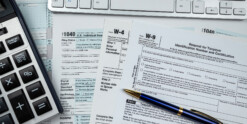OK, so I’m going to talk about the dreaded R-word — recession. Is one lurking around the corner for our nation’s economy? Should hardworking Americans be concerned about their livelihood? Their investments? The short answer is, probably not right now. But the question does merit a look at the numbers.
Right now, inflation is in check. But folks are concerned. Based on the Federal Reserve’s recent statement, we know inflation is something the agency continues to watch closely. We know the Personal Consumption Expenditures (PCE) index is the Fed’s marker of how quickly consumer prices are rising or falling (aka’s the Fed’s measure of inflation). And we know that the Fed would like to see inflation run at a 2 percent annual clip.
Let’s break this number down. The Fed believes that a 2 percent inflation rate over time leads to general price stability and full employment over time. Historically, high or extreme inflation rates reduce our ability to make accurate long-term economic and financial decisions. The flip side is that a lower inflation rate is associated with elevated probabilities of falling into deflation. When deflation hits, prices and wages tend to fall, making it increasingly difficult for consumers to service their debt; that leads to even further economic strife. So having a small level of inflation is actually an economic positive, and means we are less likely to experience harmful deflation.
Now, how does inflation impact stocks? While some inflation is healthy for the economy, extreme inflation can be a death toll for stocks. The logic here is that as inflation rises (particularly above the 4 percent level), the market’s price to earnings ratio (P/E) responds by contracting. Shrinkage to the P/E ratio is due to inflation’s erosive nature on the true value of a company’s earnings. When inflation hits, investors reduce the amount they are willing to pay for those earnings. The result? Weaker returns from the stock market.
In addition to keeping an eye on the Fed, savvy investors pay attention to the Average Hourly Earnings (AHE) measure as an additional gauge of inflation. Why? AHE is a straightforward marker of how much companies are paying workers per hour. When this figure is on the rise, it’s a signal that the economy is healthy, the labor market is tight, and companies will have to raise wages to keep employees happy.
While a rise in AHE is positive for the economy, too much of a good thing can turn sour, as rising wages eat into corporate earnings. Once again, the R-word. As indicated over the past 35 years, when AHE climbs to 4 percent, a recession typically ensues. In the years 1981, 1990, 2001 and 2008, AHE breached the 4 percent mark right before the country headed into a recession.
But since our most recent financial crisis in 2008, growth in AHE has stayed low, hovering at around 2 percent per year. In 2016, however, we saw wages climb at a faster rate, growing in a range of 2.2 percent to 2.6 percent and hitting a post-recession high of 2.9 percent in December. So right now, AHE is trending higher but still in the “safe zone.”
High AHE numbers make the Fed anxious, which translates into economic tightening and increased interest rates. It’s like the Fed slams the brakes on economic activity. And the byproduct of this kind of slowdown is very often a recession. But remember, we’re far from the 4 percent mark now.
So the question becomes, how much time do we have if AHE continues to rise? Looking at historical data, it takes about five and a half years for AHE to bottom out. Arguably, this is what happened around October 2012. Using this timeline, we would have until mid-2018 before AHE hits 4 percent again and harkens the risk of a recession.
Though Average Hourly Earnings is an important variable to watch, it’s not the only factor influencing the economy — markets don’t rise and fall in a vacuum. While focused on general inflation and AHE, the Fed keeps a broad view of economic data points. As workers and investors, it’s good practice to look through the same lens as the Fed. While we can’t predict or prevent a recession, being aware of market trends can help us guide our investment strategies and make better decisions for the long run.
Read the original AJC article here.
DISCLOSURE
This information is provided to you as a resource for informational purposes only. It is being presented without consideration of the investment objectives, risk tolerance or financial circumstances of any specific investor and might not be suitable for all investors. Past performance is not indicative of future results. Investing involves risk including the possible loss of principal. This information is not intended to, and should not, form a primary basis for any investment decision that you may make. Always consult your own legal, tax or investment advisor before making any investment/tax/estate/financial planning considerations or decisions.













